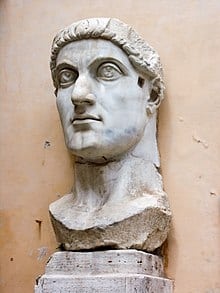
Constantine the Great
Constantine I (Latin: Flavius Valerius Constantinus; Greek: Κωνσταντῖνος, translit. Kōnstantînos; 27 February c. 272 – 22 May 337), also known as Constantine the Great, was Roman emperor from 306 to 337. Born in Naissus, Dacia Mediterranea (now Niš, Serbia), he was the son of Flavius Constantius (a Roman army officer born in Dacia Ripensis who had been one of the four emperors of the Tetrarchy). His mother, Helena, was Greek and of low birth. Constantine served with distinction under the Roman emperors Diocletian and Galerius. He began by campaigning in the eastern provinces (against barbarians, and the Persians) before he was recalled in the west (in 305 AD) to fight along side his father in Britain. After his father’s death in 306, Constantine became emperor; he was acclaimed by his army at Eboracum (York, England). He emerged victorious in the civil wars against emperors Maxentius and Licinius to become the sole ruler of the Roman Empire by 324.
As emperor, Constantine enacted administrative, financial, social and military reforms to strengthen the empire. He restructured the government, separating civil and military authorities. To combat inflation he introduced the solidus, a new gold coin that became the standard for Byzantine and European currencies for more than a thousand years. The Roman army was reorganised to consist of mobile units (comitatenses), and garrison troops (limitanei) capable of countering internal threats and barbarian invasions. Constantine pursued successful campaigns against the tribes on the Roman frontiers—the Franks, the Alamanni, the Goths and the Sarmatians—even resettling territories abandoned by his predecessors during the Crisis of the Third Century.
Constantine was the first Roman emperor to convert to Christianity. Although he lived much of his life as a pagan, and later as a catechumen, he began to favor Christianity beginning in 312, finally becoming a Christian and being baptised by either Eusebius of Nicomedia, an Arian bishop, or Pope Sylvester I, which is maintained by the Catholic Church and the Coptic Orthodox Church. He played an influential role in the proclamation of the Edict of Milan in 313, which declared tolerance for Christianity in the Roman Empire. He convoked the First Council of Nicaea in 325, which produced the statement of Christian belief known as the Nicene Creed. The Church of the Holy Sepulchre was built on his orders at the purported site of Jesus’ tomb in Jerusalem and became the holiest place in Christendom. The papal claim to temporal power in the High Middle Ages was based on the fabricated Donation of Constantine. He has historically been referred to as the “First Christian Emperor” and he did favour the Christian Church. While some modern scholars debate his beliefs and even his comprehension of Christianity, he is venerated as a saint in Eastern Christianity.
The age of Constantine marked a distinct epoch in the history of the Roman Empire and a pivotal moment in the transition from classical antiquity to the Middle Ages. He built a new imperial residence at Byzantium and renamed the city Constantinople (now Istanbul) after himself (the laudatory epithet of “New Rome” emerged in his time, and was never an official title). It subsequently became the capital of the Empire for more than a thousand years, the later Eastern Roman Empire being referred to as the Byzantine Empire by modern historians. His more immediate political legacy was that he replaced Diocletian’s Tetrarchy with the de facto principle of dynastic succession, by leaving the empire to his sons and other members of the Constantinian dynasty. His reputation flourished during the lifetime of his children and for centuries after his reign. The medieval church held him up as a paragon of virtue, while secular rulers invoked him as a prototype, a point of reference and the symbol of imperial legitimacy and identity. Beginning with the Renaissance, there were more critical appraisals of his reign, due to the rediscovery of anti-Constantinian sources. Trends in modern and recent scholarship have attempted to balance the extremes of previous scholarship.
Read More About Constantine the Great
Lists containing Constantine the Great :
383 Influential People who changed the world

The world is filled with thousands of great people who have changed the world. It is not possible to list the most influential men and women in human history, but this list is an attempt to explore some of the most influential people of all time that one must know about. It can be hard…

